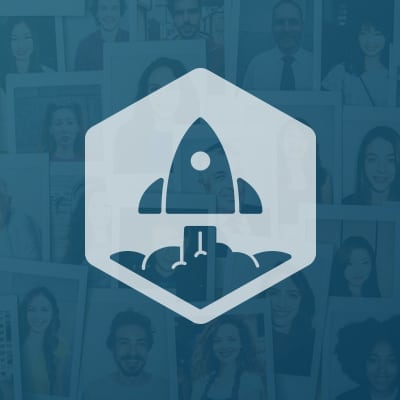NPS, or Net Promoter Score, for SaaS businesses is an important metric to measure how satisfied your customers are and one indicator of the health of the relationships you have with them. That being said, it shouldn’t actually be a metric to manage your business to, according to Lexi Reese, CXO of Gusto.
Lexi joins Joshua Reeves, CEO of Gusto, on the Tactical stage where they both discuss how you should actually think about NPS and what it takes to run a truly customer-driven organization. You need to think about which customers your business is designed for and who it’s bad for. What kind of talent should you try to attract? How do you decide where to make hard tradeoffs?
There are many things to think about when it comes to making your customers successful and happy, but it all starts with an inherent desire to serve, something that cannot be manufactured.
And if you haven’t heard: SaaStr Annual will be back in 2018, bigger and better than ever! Join 10,000 fellow founders, investors and execs for 3 days of unparalleled networking and epic learnings from SaaS legends like Eric Yuan, Tomasz Tunguz, Chris O’Neill, and Mikkel Svane. If you don’t have tickets, lock in Early Bird pricing today and bring your team from just $999! (All ticket prices go up January 1st.) Get tickets here.
TRANSCRIPT
Anthony Kennada: The title of this session is “How to Get to NPS 75 with 40,000 Customers.” There’s a lot of different benchmarks out there for NPS for B2B software companies. The average we’re hearing something in the 30 range. If you get to 50, you’re doing great. If you get to 75, that’s pretty amazing. We’re going to learn from some of the experts here.
Our speakers are Joshua Reeves, the CEO of Gusto and Lexi Reese, the Chief Customer Experience Officer of Gusto. Gusto has built a product that offers one intuitive place to manage payroll, benefits, and HR for small businesses and over 40,000 small businesses in the platform. Let’s welcome to the stage.
Joshua Reeves: Thank you.
[applause]
Joshua: Hi, everyone. My name is Josh. I’m the co founder and CEO of Gusto. This is my colleague, Lexi. She leads our customer experience team. We’re thrilled to be here today. We’re going to be talking about NPS, which is a way of saying customer experience, customer satisfaction.
Why that matters is it drives the bottom line, things like retention. You want to keep the customers that you get, especially in a subscription business. It’s also just the right thing to do in terms of serving your customer well.
I’m going to be sharing parts of our philosophy, various pieces of advice from the early days at Gusto. Lexi will be sharing some five key insights on how to operationalize and scale those philosophies as we’ve grown to over 40,000 customers.
Before I dive in, I want to give a quick description of what is Gusto. We are the people platform. What that means is we help you build great teams, pay those teams, help them do great work, and also stay compliant. That’s things like payroll, health insurance, 401(k), onboarding. For us, it’s a really exciting thing to be involved with.
We actually started the company, me and two co founders, because we had felt the pain ourselves. We had basically run prior businesses, has been frustrated with that experience and felt like it could be done better. We had family that had run small businesses as well. We realized that a lot of folks were in pain.
It’s actually a good connection to the first piece of advice, which is, “Really understand why you’re starting your company, what your motivation is, what drives you, what inspires you.” For us, it was all about that problem. This problem of how people build companies not making it purely a transactional relationship.
When we thought about what is that origin, again, for us, it’s not about being…I think Silicon Valley gets caught up, are you engineering driven, sales driven, and product driven? We are customer driven.
The way we describe it is, we’re solving a problem by building a business. We’re not creating a business for the sake of it. Make sure you understand why you’re starting your company and if service is a part of it, then that should be very authentic.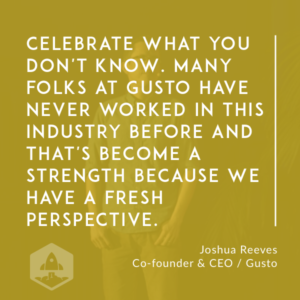
Second piece of advice is really to celebrate what you don’t know. In our case many folks at Gusto have never worked in this industry before and that’s become a strength because we have a fresh perspective.
As we spend more time in the industry, it’s been fun. You talk to someone about payroll, the first thing they say is, “That’s a chore. That’s a hassle.” If they are really affected by it, they’d say, “It’s a headache or a nightmare.” For us, we always believed that the building blocks of what we’re creating here were in inherently delightful, they’re people getting paid.
I mean I walk around San Francisco, I was in New Orleans last year wearing a Gusto t-shirt and people go, “Hey, payday guy.” It’s a wonderful thing to be a part of. People love to get paid and we send those emails to several hundred thousand people saying, “You got paid today.”
On the employer side, it’s a chance to celebrate and acknowledge someone’s hard work, so we always just had a different perspective. For us, the hypothesis was people would actually love their payroll company and I think with 40,000 customers, some good progress over the last few years, we’ve proven a part of that to be very true.
Third piece of advice is to really understand what makes you different, what makes you special, what sets you apart? For Gusto, that’s a combination of incredible technology and software and also really, really great people, amazing service. For us, it’s almost a pragmatic trade off.
I think again in Silicon Valley, folks get caught up in these discussions of, “Does software fix everything or not?” I think that’s a binary choice, the truth is it’s nuanced. When it comes to things like payroll taxes, there’s 10,000 payroll taxes across the US. Just let that settle in. 10,000 different payroll taxes, local, state, and federal.
If any of you know those rules specifically, God bless you. If not, we’re here to help you, but the point is that should be done in software. That’s an automated system.
A business is not better off filling out a form for the fifth time in a black pen or a blue pen, it just has to be done correctly. We use a lot of automation and software to do the things that are better done in software.
We’re filing today hundreds of millions of documents, tens of billions of dollars of payments, but if a customer ever wants to call in and talk to us, a partner has a question, we’re going to give them an amazing experience because that’s a human touchpoint with someone, which is why we exist to make their life better.
That feedback loop, we want to help them, and as soon as that call ends, try to figure how to prevent it from happening ever again.
That feedback loop is really, really critical. Even early on, our customer care team and our product team were very, very integrated because those two teams have the same exact purpose, to make the product better, to make the experience better for the customer.
Fourth piece of advice, I’m going to take a bit of a step back. I actually was born and raised in the Bay Area, one of the few locals out here and I’ve seen the tech cycle come and go over the last few decades. The main message I have irrespective of where you are, wherever you are in the world, is that there are no shortcuts.
Especially in our industry for example, which is a compliance industry. We’re doing something very mission critical for the customer. We’re making sure they get paid on time so that they can make rent. Making sure that they get insurance set up correctly so if their kid gets sick, they’re taken care of. There is no shortcut. Silicon Valley can sometimes become an echo chamber.
If you really just go back to the basics, what really matters is the same thing that matters to any company. Serve your customer well, do it in a way you’re proud of, and build a sound business. Especially that partnership aspect, that’s what I love about SaaS, that’s what this conference is all about.
The word software as a service, service is all about partnership, it’s a subscription revenue. We’re taking 5 of these 20 hats off of our customers’ head and if we do our job well, they are going to pay us forever. That’s pretty awesome. If we don’t do our job well, they’ll leave us. That’s the way it should be.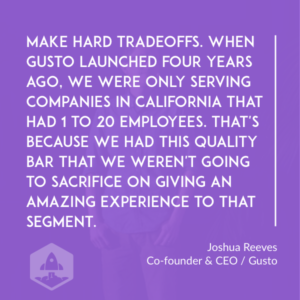
The advice point here is, especially around make hard tradeoffs. When Gusto launched four years ago, we were only serving companies in California. Really focused on companies 1 to 20 employees. That’s because we had this quality bar that we were not going to sacrifice in terms of what it means to give an amazing experience to that segment.
Today, we serve companies nationwide, all 50 states and its companies 1 to 150 employees. We’ve been very deliberate and intentional in that transition and I think many of you guys probably are in a similar boat. If you spread yourself too thin too quickly, you start sacrificing quality and then you damage why you exist in the first place, which is to fix the problem for the customer.
Last but not least on my end, it all comes back to people and especially on hiring. We have three specific philosophies at Gusto, pillars to our philosophy of hiring. The first is hiring for shared values, second is for aligned motivations, and the third is for relevant skill set.
I think a lot of folks go to the third one but that second one in particular, when you hire someone who has aligned motivations who really cares about the problem you’re trying to fix, authentically they want to tell their family about it. They’re really excited about the impact that your product is having on who you’re serving.
You really can’t create that artificially. It has to be authentic. It has to be natural. Once it’s there, it changes the way someone works. I was having lunch with a colleague recently and they were saying how they were on a client call and the person was tired and hungry and my colleague ordered them a pizza.
That’s definitely not in our training materials, that’s definitely not in our policy but it was something that felt right. It was grass roots. If you hire for people that again share that motivation, then they’ll do those different actions in a way that just makes sense for the business.
Speaking of people, thrilled to actually welcome Lexi up now to share some more tactical advice. She’s been with us for about a year and a half and joined us from Google.
Lexi Reese: Awesome, thanks Josh. All right, so in honor of the performance, we’re going to do this according to the Hamilton musical. We’re going to do this next part, is that cool with you guys?
Yeah? All right, Josh, you weren’t prepared for that but you’re ready.
Joshua: I can bring it.
Lexi: All right. I’m going to dive deep into the how to part of this but the disclaimer is, the talk is How to NPS 75 40K Customers and I don’t believe an NPS is a metric to manage your business to. Obviously, there’s lots of conversations on this topic.
NPS is an amazing forensic tool, starts great conversations cross functionally. It’s an awesome rallying cry to make your employees excited and motivated about what to do or to stop doing. It’s a signal to both your customers and your employees that you care.
But Frances Frei who wrote, what I think is the most important book that you can read on customer experience at scale, it’s called Uncommon Service. Talks about NPS and she really distills it in a way that rings with me, which is, NPS is often adopted on faith, it’s not evidence based.
Faith based metrics lead to a lot of investments, people, money investments, and things that don’t result in needle moving improvements and cost effective growth.
We’re going to change the talk from how to whatever it was originally called to what five questions do you need to answer for your business to achieve stellar financial performance while earning the right to have customers who love you and want to talk about you? The question one is, what is your strategy?
Make no mistake. You cannot be Switzerland on this. You have a product strategy. You have a go to market strategy, but when I ask people, “What is your customer experience strategy?” often they’ll say, “Well, NPS or CSAT.” That’s not a strategy. A strategy is reflected in the following.
You have a deep understanding of whether you’re going to differentiate your product based on your service that you provide, or you’re going to differentiate somewhere else. If you’re going to differentiate somewhere else, I’ve worked in companies that can differentiate in product, and they have the benefit of network effect. Service and experience is an afterthought.
Me, too–being exactly like your competition, is a strategy. How many of you just by show of hands, I can barely see you because the lights are so bright, have had an experience recently where it’s been pretty horrible? You’ve had a customer experience and it results in a story? Just show of hands.
“Oh, my God.” Insert the name of that telco company, cable provider, or usually airline. “I can’t effing believe. I was in line. I was waiting for an answer. I didn’t get my question solved.” How many? Okay. Guess what? Someone at that company is tracking NPS diligently. They probably have a poster or at least 17 slide decks that say, “The customer matters. Be customer focused, customer first.”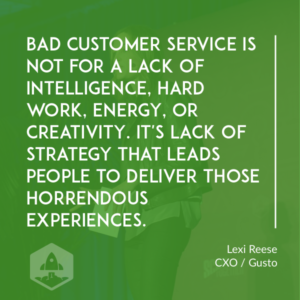
They believe it. It’s not for a lack of intelligence, hard work, energy, or creativity. It’s lack of strategy that leads people to deliver those horrendous experiences. If you’re going to differentiate on customer experience, which presumably you are because you’re here, then it comes down to really simple questions.
For your journey, for the journey your customer goes on, and for your product lines, where will you sit on the spectrum, the two by two, of quality of service and cost? Quality of service is really simply how much are you willing to accommodate the variable preferences of your customers? What questions are they calling you about or contacting you about? Why? When?
How much effort did they want to put into the answer? High quality of service? You got to find that way to pay for it. Low quality of service, which is usually just restricting the choice on those dimensions, you often can charge less.
If we go back to Frances Frei for a second and we go back to why net promoter doesn’t help as a metric to manage your business, using this paradigm I can get you to recommend Gusto every time.
Guess what? It’s free. I have 24/7 service available to you around the sun. I’ll contact your tax agency every time about every issue that you might have, some of which Josh described.
That is not a cost effective way to scale. Question number one, what is your customer experience strategy?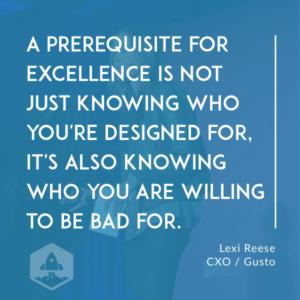
Question two, related but needs to be pulled out separately. Who are you willing to be bad for? A number one prerequisite for excellence is not just knowing who you’re designed for. It’s who are you willing to be bad for.
The best example of this may be one you can relate to or studied is Southwest. Their strategy is low cost excellence. They have figured out a way that, contrary to popular belief in an airline, you don’t have to make people miserable while charging them exorbitant prices and putting them in cattle car situations. You don’t have to. You could actually be a profitable airline.
Their choice, low cost excellence, designed for the budget traveler. That’s not just accident that they made those two and stopped there. The approach to get to low cost excellence, one, is gate space, discounts. By going out of the way airlines, you can get gate space for cheap. They lower their costs. Two, no meals. No time switching out the trays between flights’ on time departures.
They nailed it for their design target. They deliver on time flights at a low cost. When the random luxury United dude shows up on a Southwest flight and then extracts his energy in an NPS survey saying how bad Southwest is, they don’t freak out. They actually celebrate it because they say, “This is our strategy at work. We’re designed for someone different.”
Who are you willing to be bad for?
Question three. You’ve got your strategy. You’ve got your target. How do you actually bring this to life? How do you live it? How do 400 people in your organization or 1,000 or 3,000…How does it manifest? There’s a framework that works for Gusto. It might be different for you, but hopefully it’s pretty simple after you have your strategy.
For us, it’s listen, hire, and engineer. Listen. This seems so basic. Why do you even bring it up? Really programmatically and personally listen to your customers regularly.
We publish monthly a voice of the customer pack. Hopefully, you guys do the same. It’s every manner of qualitative and quantitative metric about our customers. We publish it to the entire company.
We use that in a product prioritization process that’s pretty ruthless on based on our strategy, what do we need to do to improve? We also bring customers in. Matthew, who’s somewhere here, was recently here and has provided really amazing feedback. Personally, I, Josh, our co founders, no one is removed from handling customer escalations. We do that regularly.
This manifests really practically. If we’re having a meeting on customer experience, and I say, “Who in the room has talked to a customer in the last week?” and there’s nobody who has, cancel the meeting. Get on the phone. Sell something or go service someone, but we shouldn’t be having a meeting.
Two is hire. Josh talked. Josh makes this job really easy because he’s created this incredible platform around values, motivation, and skill set. Specifically, your skill set for the people who are handling the privilege of handling your customers every day has to be aligned to your strategy. For us, this is intellect, empathy, energy, and diversity.
Diversity because we serve the world. We would serve the world. We serve the US. We want to be as diverse as the customers and the employees we represent.
Intellect, energy, and empathy because there is no manual. Even if we wanted to, we could not script the 7,000 variations of tax questions, health insurance questions, retirement questions. There’s no way we could script them all.
By hiring the right people, empowering them with just the right amount of information to do their job well, I get a call from a customer who called to share, “I need to tell you, Lexi. You guys screwed up.” And I was pissed. I was worried. I was going to have a huge tax issue on my hand.
Kelsey picked up the phone. She asked the right questions. She was calm. I was not. She asked the right questions. She took the time to solve the issue I had and then probed to solve the one I didn’t even know I had. She turned something around. I would love to say you’re going to be perfect at this every time. That’s really hard.
We depend on state agencies and health insurance providers. Even if we’re perfect, we have partners that may not be as tech forward. Therefore, we have to deal with variability. Kelsey’s handling of that situation is amazing, unscriptable.
Finally, engineer for solutions. After you’ve listened to your customers and your teams that can provide great feedback, engineer solutions.
We have a mantra. If get an issue 10 times, we don’t get it the 11th because the product has been fixed. The insight being for the businesses we serve, time is their most valuable asset. We’ve got to give it back to them, so don’t get the issue in the first place. If we must get it, Nick Soman here. He’s an amazing product and engineer leader.
Design a way for the customers we serve to self discover that, so they don’t have to pick up the phone or chat or what have you. Finally, if we must get it, then we need to invest in training our teams to be the best at answering that issue in tone, in manner, and in the medium that the customers desire. Again, what’s your framework for activating that strategy and bringing it to life?
Question four, and then there’s only one after this if you’re getting antsy. Question four is, what do you do when things go wrong? They will go wrong. The fastest path to satisfaction is reaction and building mechanisms to react quickly and thoroughly to issues. You don’t need to understand this beyond bueno and no bueno.
Bueno is when customers have issues we get to them faster than they’re being created. No bueno is the reverse. For everybody in this room, I would imagine you’re in super high growth situations where, despite your best efforts in strategic planning, instrumentation, hiring, you get in situations where growth outpaces your ability to service the customers who have joined you. This happens.
You can do a couple things. You can throw bodies at that issue. Throw bodies. High five. Pizza party. 24/7. Woo! We got through it.
You’re back in it three months later definitely. You definitely are. Heroics are not what get you to scale. When this situation happens, having a leadership team in place that can quickly go through the seven stages of grief.
“Oh, shit. Why did this happen? I can’t believe it. I’m so sorry.” Having partners that will be patient with you. One customer in this time told me, “Lexi, this is great that you’re growing, but you’re growing on my back.” That’s the worst thing that could happen.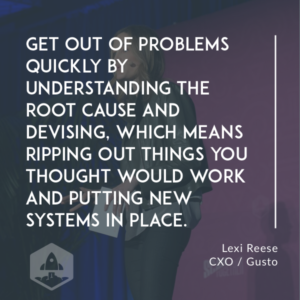
Get quickly out of it by understanding the root cause and devising, which means ripping out things you thought would work and putting new systems in place so that you can sustainably, scalably get out of the situation for the future.
I’m happy to say that we did get out of the situation. I’m sure we’ll be in it again, but we’ll get out of it even faster.
Last question is what are your non negotiables? People talk about a due North. You’ve got a strategy. You’ve got a design target. In scaling organizations, a lot gets caught up in financial metrics, in ratios, and, “Hey, you can only have one advocate to X number of customers.” There are some things that just will not bend to the rules of whatever scale metric works for your business.
You still have to invest in them. Josh mentioned this. We are a all in one HR platform that aims to empower people to create better lives for themselves through payroll, through health insurance, through really important tasks. We have to be a compliant leader.
We have invested heavily in our teams and our product in able to be sure that our customers and ourselves stay current on the ever changing regulations and rules in our space. We have zero tolerance expressed in every way you can imagine. If someone doesn’t play by these rules or take shortcuts, it’s easy to do. Whatever it is in your business, agree on what that non negotiable is.
Make it easy for your teams to never feel like they have to take a shortcut because they know you support it. The five questions that I just went through hopefully…We’re going to be here for a long time and love to geek out on this. It is amazing to be on this journey with Josh, as I said, who set the course for this.
I’ll pass the mic to you, this is like Regis and Kelly, for you to take us home.
Joshua: Thank you, Lexi. Always an honor to work with you and to share the stage.
Just to summarize, I wanted to really emphasize two specific points. Number one, the desire to serve should come from within. Really spend that time. I think of it as an introspective exercise, not just if you’re a founder but if you’re someone joining. It’s always about alignment.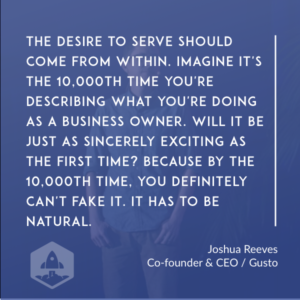
One of my best tips on this is, imagine it’s the 10,000th time you’re describing what you’re doing as a business owner. Think about if it’ll be just as sincerely exciting and you’ll be as passionate as the first time because by the 10,000th time, you definitely can’t fake it. It has to be natural.
If you have that motivation, if you do connect with the problem, then something like serving is not a debate topic. There’s a lot of ways to structure it, but ultimately it does come from within.
Second, this one is more related to again the importance of making tradeoffs. In our case it was funny when we were launching only in California. We had customers signing up across the country.
I can’t tell you guys how many conversations I’ve had, emails, where it was something along the lines of, “Well, it’s not you. It’s me. We’re not ready yet. We’re not even gonna give you access yet. We’ll turn away thousands and thousands of customers. We’ll get them eventually, but we’re being very deliberate and intentional on who are we great for now and who are we not gonna be great for?”
I think that’s just a mindset that again is really important to any startup that has a lot of potential because hopefully you’ll be doing it for a while. I hope to spend many, many decades building Gusto.
Without further ado, I want to wrap. Thank everyone for joining. We’ll hang out for a bit as well. If you’re a Gusto customer, we’re honored to serve you. If you’re not, come check us out. Thank you very much.

